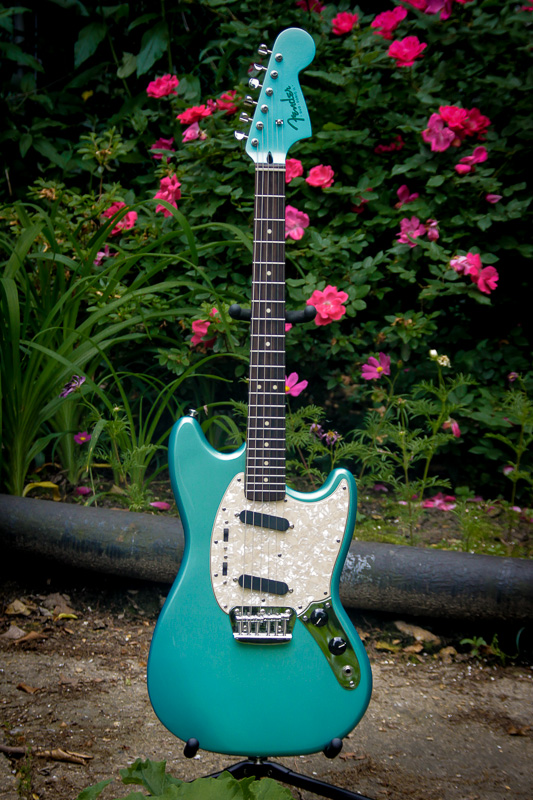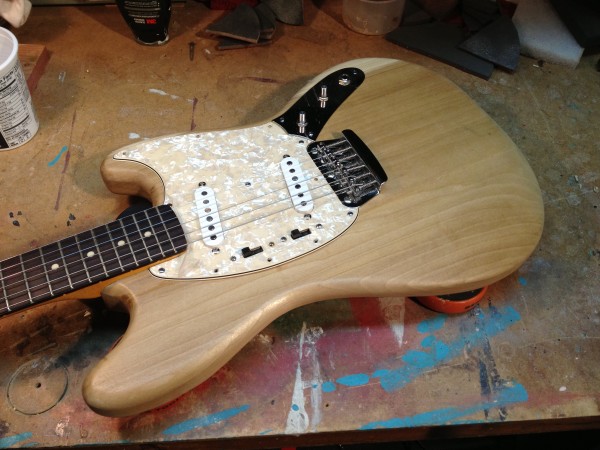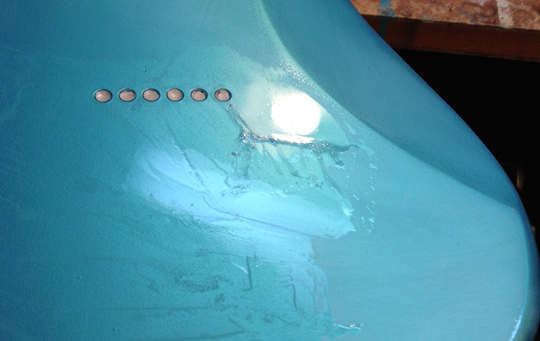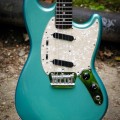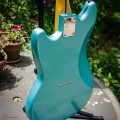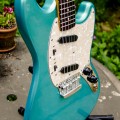I haven’t posted any of the projects I’ve been working on for a while, but this one came out really well, so I thought I’d share it. I still haven’t worked my way up to building a guitar from scratch yet, but I have been slowly accumulating the tools and knowledge.
This copy of a Duo-Sonic II was built from a custom made body by a guy that goes by the online name of “Cooterfinger”. He hangs out in various guitar forums and seems to make a lot of the Fender offset body types. It’s made of poplar just like the original Duo-Sonics, and was really well crafted. Here’s a photo of it unpainted where I was test fitting everything.
I originally tried using a neck from a mini strat. The scale length on those is 22.75″. The original Duo-Sonics had a 22.5″ scale, so I was curious as to what such a short scaled guitar would be like. But I hadn’t realized that, when you use one of the mini-strat necks on a Duo body, you need to move the bridge back .25″, and thereby also needing a custom pickguard that would be longer to fill the extra gap. I had already drilled the holes for the bridge and bought the pickguard, so I bought a new neck, which ended up being from a Squire Vintage modified Jaguar. These are 24″ scale like later Duos.
For the finish, I wanted to try using pearl powders. I ended up going with a color change pearl called “Caribbean Blue-Green”, from the website – CustomPaintingPearls.com. The color shifting effect on this combination is very subtle, it tends to just look either more blue or more teal depending on the light. The site recommends putting the pearls over a dark base color. Rather then adding an extra layer of black paint, I just added some black transtint to the sand and sealer.
I mixed the pearls into nitrocellulose lacquer. I actually got the lacquer at my local Sherwin Williams which was really convenient, and a lot cheaper then the online options I have used before. It was only about $30 for a gallon. I think I mixed about a teaspoon of powder into half a quart of lacquer, and it took 3 or 4 coats, about an hour apart, to where I felt satisfied that I had even coverage. Over several days, I then sprayed the 10 to 12 coats of clear.
As I mentioned, the neck was from a Squire Vintage modified Jaguar. It was maple with a rosewood board. I much prefer a Truoil finish on necks to poly or even glossy nitro, and I think the amber they use on Squire necks is too orange looking. So I stripped off the poly, so I’d have raw wood to stain. For that I mixed some transtint amber, a little dark brown, and a tiny bit of red as the mixture looked slightly green to me. I mixed it with some alcohol, diluting it till it was somewhat weak so that I could slowly build up to the tint I wanted. Then I just rubbed a few coats of Truoil over it. Not too many, as I don’t want a super glossy finish. I still want to feel a bit of the the wood texture, as this makes a faster playing neck, and doesn’t get sticky if you get sweaty.
After allowing the lacquer to cure for about 5-6 weeks, I sanded the body with 800grit sandpaper, wetsanding up through the grits to 2000. I then use a foam pad, from StewMac, in my drill with some 3M scratch remover to polish the body to a glossy shine.
One important detail when wetsanding the guitar- make sure you plug all the screw holes with something that will keep the water out. I use plumbers putty, but you could also use modeling clay or wax. The reason you need to do this, is the exposed, raw wood inside these holes will absorb any water that gets in there, and this will swell the surrounding wood. And since lacquer is a rather inflexible, brittle finish, it will crack and even pop off.
During the dry test fit, I installed some GFS Alnico strat pickups. They were OK sounding, but kind of bland. So for the final assembly, I bought some RH Factor ‘Meyer Scooped’ pickups. This was a big improvement, and it now sounds as good as it looks.
- Duo Sonic II closeup – guitarify.com
- Duo Sonic II headstock – guitarify.com
- Duo Sonic II back – guitarify.com
- Duo Sonic II another closeup – guitarify.com

